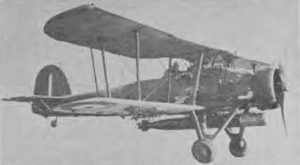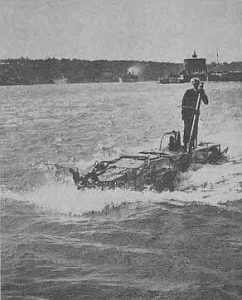- Author
- A.N. Other and NHSA Webmaster
- Subjects
- History - general
- Tags
-
- RAN Ships
- None noted.
- Publication
- December 1974 edition of the Naval Historical Review (all rights reserved)

Lt-Cmdr. E. Esmonde, DSO, RN
As the commanding officer of a squadron of Fleet Air Arm Swordfish torpedo bombers on 12th February 1942, Esmonde led a force of six aircraft on an attack on the German ships Scharnhorst, Cneisenau and Prinz Eugen and a force of destroyers, torpedo boats and minesweepers which were endeavouring to pass through the English Channel. Lieutenant-Commander Esmonde carried out his attack with resolution in the face of overwhelming odds. All aircraft participating in the attack were shot down and there were no survivors.
Temporary Lt. T. Wilkinson, RNR
As commanding officer of HMS Li Wo, a Chinese river boat, on 14th February 1942, Wilkinson engaged an enemy convoy of transports escorted by a cruiser and two destroyers southwest of Singapore Straits. Although his ship was armed with only one 4-inch gun with 15 shells, Lieutenant Wilkinson pressed his attack and when all ammunition was expended rammed a large transport, which sank the next day. Li Wo was sunk shortly afterwards and Lieutenant Wilkinson went down with his ship.
Lt. Peter S. W. Roberts, RN
Petty Officer T. W. Gould, RN
As members of the crew of HM submarine Thrasher, on 16th February 1942, they participated in a successful attack on an enemy supply ship in Suda Bay, Crete. In the ensuing counterattack two depth charges lodged between the casing and hull of the submarine without exploding. The submarine surfaced in the enemy harbour and Lieutenant Roberts and Petty Officer Gould crawled into the cavity to remove the charges, well knowing they would be drowned if the submarine was forced to dive. The first charge was removed and thrown overboard. The second was of a new type and before removing it the men noted details of its fuses in a book. Both Roberts and Gould survived to receive their decoration. (The writer sailed in Thrasher with Roberts and Gould on a previous operation in these waters.)
Cmdr. A.C.C. Miers, DSO and Bar, RN
Commander Miers was one submarine commander to live to receive his Victoria Cross. As commanding officer of HM submarine Torbay, on 3rd March 1942 Miers followed a large convoy of enemy supply ships escorted by three destroyers into Corfu Harbour. The batteries of the submarine were too low for the vessel to remain submerged, so Miers brought Torbay to the surface and charged the batteries in the enemy harbour. At first light Torbay approached the anchorage and fired torpedoes at two supply ships and a destroyer. The supply ships sank, but the destroyer attacked Torbay with repeated depth-charge patterns. Miers succeeded in extricating his vessel from the harbour and returned safely to his base.
Cmdr. R. E. D. Ryder, RN
LtCmdr. S. H. Beattie, RN
Able Seaman W. A. Savage, RN
The successful raid on St. Nazaire on the night of 27th-28th March 1942 resulted in three Victoria Crosses being awarded to Naval personnel. Commander Ryder was officer-in-command of the Naval component of the raid which consisted of the blockship HMS Campbeltown, 16 ML’s, one MTB and one MGB. The success of the raid owed much to Ryder’s bravery, skill and daring in the face of fierce enemy resistance and heavy losses.
Lieutenant-Commander Beattie was commanding officer of HMS Campbeltown in the operation. Because of his coolness and daring whilst under heavy fire, his ship was rammed into the gates of the dock. The subsequent explosion of the demolition charges in Campbeltown’s bows sealed the success of the operation. Beattie was taken prisoner of war.
Able Seaman Savage was the pom-pom gunlayer in MCB.314 during the raid. His example of engaging enemy guns at pointblank range inspired the whole force. In a savage action at the Old Entrance to the docks Savage fought an action with an enemy Bofors battery. He died soon after silencing the last gun.
Capt. F. T. Peters, DSO, DSC and Bar, RNR
During the Allied operations against North Africa in November 1942, Captain Peters commanded two ex-US coastguard cutters, Walney and Hartland, in an attempt to land a force of United States Rangers in Oran Harbour. Peters directed his two vessels to crash the boom and on entering the harbour was illuminated by Vichy searchlights and closely engaged by enemy MLs. Under intense fire from shore batteries and a cruiser and three submarines, Peters pressed forward. When he realised his ships would sink before they attained their objective he went alongside the enemy cruiser and attempted to board her. However, both Walney and Hartland sank alongside the cruiser and the survivors of the party were taken prisoners of war. Captain Peters was killed shortly after this action in an aircraft accident.
Capt. R. St. V. Sherbrooke, RN
As commanding officer of HMS Onslow and senior officer of destroyers escorting a convoy to Russia on 31st December 1942, Captain Sherbrooke saved his convoy from destruction when attacked by the German pocket battleship Admiral Scheer, the 8-inch cruiser Hipper and three destroyers. Although hopelessly outgunned, Sherbrooke thwarted every attack by the enemy ship by boldly pretending to launch torpedoes. Seriously wounded early in the action and blinded by an eye injury, he continued to direct the action through its critical stages. Captain Sherbrooke survived the battle.
Cmdr. J. W. Linton, DSO, DSC, RN
Commander Linton was the third submarine captain to win the Victoria Cross in the Mediterranean. In command of HM Submarine Turbulent from 27th February 1942 until his vessel was lost by enemy action in early May 1943, Linton consistently displayed courage of the highest order. In the period he sunk one armed cruiser, 28 supply ships, one destroyer, one U-boat and carried out numerous gun actions against railway trains and road transport.
Lt. D. Cameron, RN
Lt. B. C. G. Place, RN
These two officers commanded the midget submarines X6 and X7 in the attack on the German battleship Tirpitz in Kaafiord, Norway, on 22nd September 1943. The operation was fraught with danger and both submarines had narrow escapes after parting from their motherships. X6 became entangled in a mine mooring and X7 carried out repairs to her exhaust system in the midst of enemy shipping. Lieutenant Cameron was the first to lay his explosive charge under the Tirpitz and was taken on board. Lieutenant Place arrived soon after and his craft became entangled in the antitorpedo nets. When the crew succeeded in freeing the submarine it surfaced 30 yards from Tirpitz. Under fire, Place dived his craft and successfully laid his charges. He and his crew were also taken aboard the enemy battleship. The subsequent explosion seriously crippled Tirpitz. One of the mother ships in this operation was the double VC winner Thrasher.
Temporary Cpl. T. P. Hunter, RM
While serving with the 43rd Royal Marine Commando in Italy in April 1945, Temporary Corporal Hunter single-handedly carried out repeated attacks on German positions. Armed with a Bren gun, he deliberately attracted enemy fire to himself in order to protect his own troops who were in an exposed position. He succeeded in killing a great many enemy troops and cleared a pillbox, several houses and a strong canal position. Hunter was killed when he exhausted his ammunition shortly after his troops reached safety.

Lt I. E. Fraser
Leading Seaman J. J. Magennis
Lieutenant Fraser and Able Seaman Magennis were crew members of the midget submarine XE3 in an attack on the Japanese cruisers Nachi and Takao in the Johore Strait on 31st July 1945. In the attack on the enemy cruisers, Fraser as commanding officer and Magennis as diver showed the greatest courage and resource. Their target, Takao, lay in shallow water and it was necessary for X3 to scrape the sea bottom to position her charges under the keel. Fraser was aware that the tide was falling and there was a distinct possibility X3 would be crushed under the ship. Magennis, to release the explosive charges, had to leave the submarine. On attempting to secure the limpet mines to the ship, he found the hull so covered with barnacles that it was necessary to scrape the steel clean. Eventually the mines were secured by cords and Magennis returned to X3. On their way back to safety it was found necessary to release the charge containers from X3’s hull and Magennis once more left the craft to carry out the task. X3 escaped and was later retrieved by her mother ship, Stygian. Takao was immobilised by the attack.
Lt. R. H. Gray, DSC, RCNVR
The last naval Victoria Cross of World War II was won by a Fleet Air Arm pilot in August 1945, a few days before the war ended. Gray led a strike from HMS Formidable in an attack on Japanese shipping in the Bay of Onagawa Wan. Selecting a destroyer as his own target, he pressed the attack with determination. Although repeatedly hit by accurate anti-aircraft fire, he dived to 50 feet before releasing his bomb. The destroyer exploded and sank almost simultaneously as Lieutenant Gray’s aircraft plunged into the sea.




